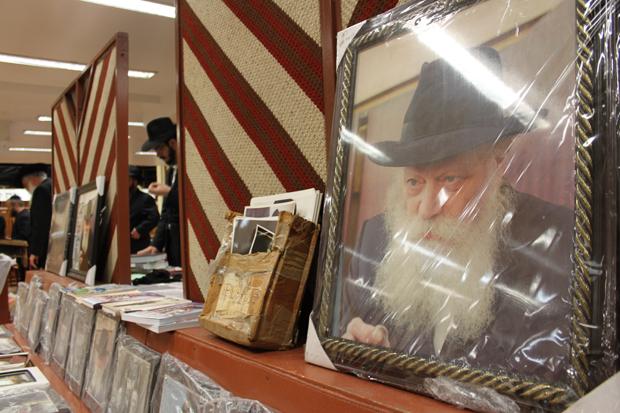The Rebbe’s Anniversary and Legacy
A photograph of The Rebbe at 770 (Photo: Daniel Estrin)
By Daniel Estrin
Last month marked the 17th anniversary of the death of a very influential rabbi. Called simply “The Rebbe,” Menachem Mendel Schneerson was the last leader of the orthodox Jewish Hassidic movement known as Chabad.
From his headquarters in Crown Heights, Brooklyn, Rebbe Schneerson expanded the movement into what it is today — arguably the most prevalent face of Judaism around the world.
Rabbi Moshe Kotlarsky, vice chairman of Chabad’s educational arm, oversees the Chabad representatives — 4,124 married couples located on every continent except Antarctica. He whittled off a list of their locales by heart: Thailand, Kaosamai, Chang Mai, Phuket, Pataya, Nepal, Kathmandu, Zambia, Zimbabwe, Cameroon, Uganda, and more.
“There are Jews in places where you wouldn’t imagine,” Kotlarsky said.
In many of those places, though, there is no rabbi or active Jewish community. That’s where the Chabad representatives come in. “It is our job to set an example,” Kotlarsky said.
Setting an example isn’t always easy for the emissaries; recently it was tragic. In the 2008 Mumbai terror attack, a Chabad center was targeted and the local emissaries lost their lives.
In many places, the emissaries are the only recognizably Jewish people around — the man wearing a long beard and black fedora, and his wife covering her hair with a wig for modesty. They don’t always get a warm welcome either; some local Jews call them proselytizers.
“We don’t have a right to impose,” said Rabbi Kotlarsky, “We do have a right to set an example.”
Chabadniks, as they’re known, try to bring Jews into the fold; they don’t look to convert outsiders. On Hannukah, emissaries light jumbo menorahs at the Champs Elysees, the Kremlin, and the Great Wall of China. In South America, they host thousands of backpackers for the traditional Passover meal, many of them young Israelis looking for a spiritual fix.
When they’re stateside, though, there’s one address in Brooklyn to which the emissaries always migrate.
At 770 Eastern Parkway in the Crown Heights neighborhood of Brooklyn is an old gothic mansion, and Chabad world headquarters. Most call it simply “770.”
“On many levels, it’s a profound space,” said Rabbi Simon Jacobson, once a scribe of the Rebbe and now a teacher and head of the Meaningful Life Center.
Rebbe Schneerson prayed, lectured, and worked at 770 until his death in 1994. Many people still flock to the building, so many years after the Rebbe’s death, Jacobson said.
“From a more mystical perspective, when a holy man spends time in a place, prays and cries there … we believe that the physical stones and bookshelves and desk become saturated with holiness,” Jacobson said.
As the Rebbe transformed the movement into a global network, the building began to take on a life of its own. Duplicates of 770 started popping up around the globe. Today, there are replicas in Milan, Melbourne, Sao Paolo, Ukraine, and Israel, and more are in the works.
Some Chabad adherents believe there’s a hidden meaning in the address of Chabad headquarters. Standing outside 770, Rabbi Joseph Spielman of England explained it through Gematria, a kind of Hebrew numerology in which letters have numerical value.
“Beis Mashiach – house of Messiah – is the numerical value of 770,” Spielman said. “The Rebbe is Mashiach (Hebrew for Messiah). This is his home.”
When the Rebbe was alive, some of his followers believed him to be the long awaited messiah. Seventeen years after his death, there are still those who fervently believe that, especially those who pray at 770. On a recent afternoon in the synagogue in 770, a group of men finished the traditional prayers by clapping and singing, “Long live our master, our teacher, our Rabbi, King Messiah, forever and ever.”
Leaders of the movement do not support this belief, said Baila Olidort, editor in chief of Chabad’s official news service. She prefers a different interpretation of 770; she said the number is the numerical equivalent of faratzta, a Biblical word meaning “to spread out.”
That was the Rebbe’s legacy: not just a headquarters at 770, but branches of the movement around the world.
“He did not leave his followers with nothing,” said Maya Balakirsky Katz, author of The Visual Culture of Chabad. “Instead of naming an heir, he named a building. Everyone’s like, why didn’t he name an heir? He did: 770.”
That global network of Chabad centers, Katz said, is helping keep the movement alive without him.
We want to hear your feedback so we can keep improving our website, theworld.org. Please fill out this quick survey and let us know your thoughts (your answers will be anonymous). Thanks for your time!
